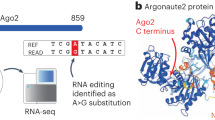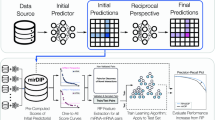Abstract
MicroRNAs are small noncoding RNAs that recognize and bind to partially complementary sites in the 3′ untranslated regions of target genes in animals and, by unknown mechanisms, regulate protein production of the target transcript1,2,3. Different combinations of microRNAs are expressed in different cell types and may coordinately regulate cell-specific target genes. Here, we present PicTar, a computational method for identifying common targets of microRNAs. Statistical tests using genome-wide alignments of eight vertebrate genomes, PicTar's ability to specifically recover published microRNA targets, and experimental validation of seven predicted targets suggest that PicTar has an excellent success rate in predicting targets for single microRNAs and for combinations of microRNAs. We find that vertebrate microRNAs target, on average, roughly 200 transcripts each. Furthermore, our results suggest widespread coordinate control executed by microRNAs. In particular, we experimentally validate common regulation of Mtpn by miR-375, miR-124 and let-7b and thus provide evidence for coordinate microRNA control in mammals.
This is a preview of subscription content, access via your institution
Access options
Subscribe to this journal
Receive 12 print issues and online access
$209.00 per year
only $17.42 per issue
Buy this article
- Purchase on SpringerLink
- Instant access to full article PDF
Prices may be subject to local taxes which are calculated during checkout




Similar content being viewed by others
References
Bartel, D.P. MicroRNAs: genomics, biogenesis, mechanism, and function. Cell 116, 281–297 (2004).
Cullen, B.R. Transcription and processing of human microRNA precursors. Mol. Cell 16, 861–865 (2004).
Ambros, V. The functions of animal microRNAs. Nature 431, 350–355 (2004).
Barad, O. et al. MicroRNA expression detected by oligonucleotide microarrays: system establishment and expression profiling in human tissues. Genome Res. 14, 2486–2494 (2004).
Doench, J.G. & Sharp, P.A. SiRNAs can function as miRNAs. Genes Dev. 17, 438–442 (2003).
Hobert, O. Common logic of transcription factor and microRNA action. Trends Biochem. Sci. 29, 426–428 (2004).
Brennecke, J., Hipfner, D.R., Stark, A., Russell, R.B. & Cohen, S.M. Bantam encodes a developmentally regulated microRNA that controls cell proliferation and regulates the proapoptotic gene hid in Drosophila. Cell 113, 25–36 (2003).
Stark, A., Brennecke, J., Russell, R.B. & Cohen, S.M. Identification of Drosophila microRNA targets. PLoS Biol. 1, E60 (2003).
Rajewsky, N. & Socci, N.D. Computational identification of microRNA targets. Dev. Biol. 267, 529–535 (2004).
Enright, A.J. et al. MicroRNA targets in Drosophila. Genome Biol. 5, R1 (2003).
Lewis, B.P., Shih, I.H., Jones-Rhoades, M.W., Bartel, D.P. & Burge, C.B. Prediction of mammalian microRNA targets. Cell 26, 787–798 (2003).
Kiriakidou, M. et al. A combined computational-experimental approach predicts human microRNA targets. Genes Dev. 18, 1165–1178 (2004).
John, B. et al. Human MicroRNA targets. PLoS Biol. 2, e363 (2004).
Rehmsmeier, M., Steffen, P., Hochsmann, M. & Giegerich, R. Fast and effective prediction of microRNA/target duplexes. RNA 10, 1507–1517 (2004).
Rajewsky, N., Vergassola, M., Gaul, U. & Siggia, E.D. Computational detection of genomic cis-regulatory modules applied to body patterning in the early Drosophila embryo. BMC Bioinformatics 3, 30 (2002).
Schroeder, M.D. et al. Transcriptional control in the segmentation gene network of Drosophila. PloS Biol. 2, E271 (2004).
Doench, J.G. & Sharp, P.A. Specificity of microRNA target selection in translational repression. Genes Dev. 18, 504–511 (2004).
Banerjee, D. & Slack, F. Control of developmental timing by small temporal RNAs: a paradigm for RNA-mediated regulation of gene expression. Bioessays 24, 119–129 (2002).
Reinhart, B.J. et al. The 21-nucleotide let-7 RNA regulates developmental timing in Caenorhabditis elegans. Nature 24, 901–906 (2000).
Karolchik, D. et al. The UCSC Genome Browser Database. Nucleic Acids Res. 31, 51–54 (2003).
Lewis, B.J., Burge, C.B. & Bartel, D.P. Conserved seed pairing, often flanked by adenosines, indicates that thousands of human genes are microRNA targets. Cell 120, 15–20 (2005).
Poy, M.N. et al. A pancreatic islet-specific microRNA regulates insulin secretion. Nature 432, 226–230 (2004).
Pruitt, K.D., Tatusova, T. & Maglott, D. NCBI Reference Sequence (RefSeq): a curated non-redundant sequence database of genomes, transcripts, and proteins. Nucleic Acids Res. 33, D501–D504 (2005).
International Chicken Genome Sequencing Consortium. Sequence and comparative analysis of the chicken genome provide unique perspectives on vertebrate evolution. Nature 432, 695–716 (2004).
Sinha, S., van Nimwegen, E. & Siggia, E.D. A probabilistic method to detect regulatory modules. Bioinformatics 19, i292–i301 (2003).
Griffiths-Jones, S. The microRNA Registry. Nucleic Acids Res. 32, D109–D111 (2004).
Acknowledgements
We thank V. Miljkovic and S. Pueblas for preparing figures for the manuscript. N. Rajewsky thanks T. Tuschl, P. Macino and F. Piano for discussions. This project was funded in part by a grant from the US National Institutes of Health (to M.S.). D.G. acknowledges a scholarship by the German Academic Exchange Service. K.C.G. and P.M. were supported by grants from the US National Institutes of Health (to F. Píaro) and the US National Science Foundation (to K.C.G.). This research was supported in part by the Howard Hughes Medical Institute grant through the Undergraduate Biological Sciences Education Program to New York University.
Author information
Authors and Affiliations
Corresponding author
Ethics declarations
Competing interests
The authors declare no competing financial interests.
Supplementary information
Supplementary Table 1
Set of 58 unique microRNAs conserved in human/chimp/mouse/rat/dog/chicken. (XLS 12 kb)
Supplementary Table 2
Predictions for single microRNA targets based on conservation in human/chimp/mouse/rat/dog/chicken. (XLS 2795 kb)
Supplementary Table 3
Predictions for single microRNA targets based on conservation in human/chimp/mouse/rat/dog. (XLS 8613 kb)
Supplementary Table 4
Predictions for combinatorially targeted transcripts in four different tissues for sets of co-expressed microRNAs. (XLS 393 kb)
Supplementary Note
Detailed description of the PicTar probabilistic scoring method. (PDF 69 kb)
Supplementary Methods
The nematode sequence datasets, evolutionary conservation check and testing the quality of vertebrate alignments. (PDF 19 kb)
Rights and permissions
About this article
Cite this article
Krek, A., Grün, D., Poy, M. et al. Combinatorial microRNA target predictions. Nat Genet 37, 495–500 (2005). https://doi.org/10.1038/ng1536
Received:
Accepted:
Published:
Issue Date:
DOI: https://doi.org/10.1038/ng1536
This article is cited by
-
miR-132-3p and KLF7 as novel regulators of aortic stiffening-associated EndMT in type 2 diabetes mellitus
Diabetology & Metabolic Syndrome (2023)
-
Extracellular vesicle–encapsulated miR-10a-5p derived from MDSCs restrains germinal center B cells in experimental Sjögren’s syndrome
Immunologic Research (2023)
-
Potential role of microRNAs in pancreatic cancer manifestation: a review
Journal of the Egyptian National Cancer Institute (2022)
-
Systematic characterization of seed overlap microRNA cotargeting associated with lupus pathogenesis
BMC Biology (2022)
-
Identification of serum MiRNAs as candidate biomarkers for non-small cell lung cancer diagnosis
BMC Pulmonary Medicine (2022)



